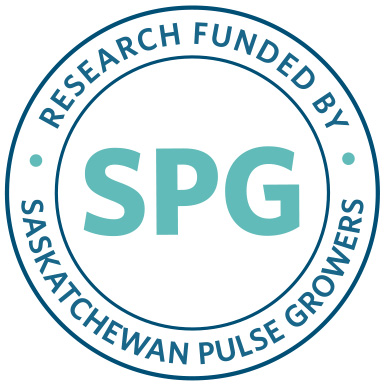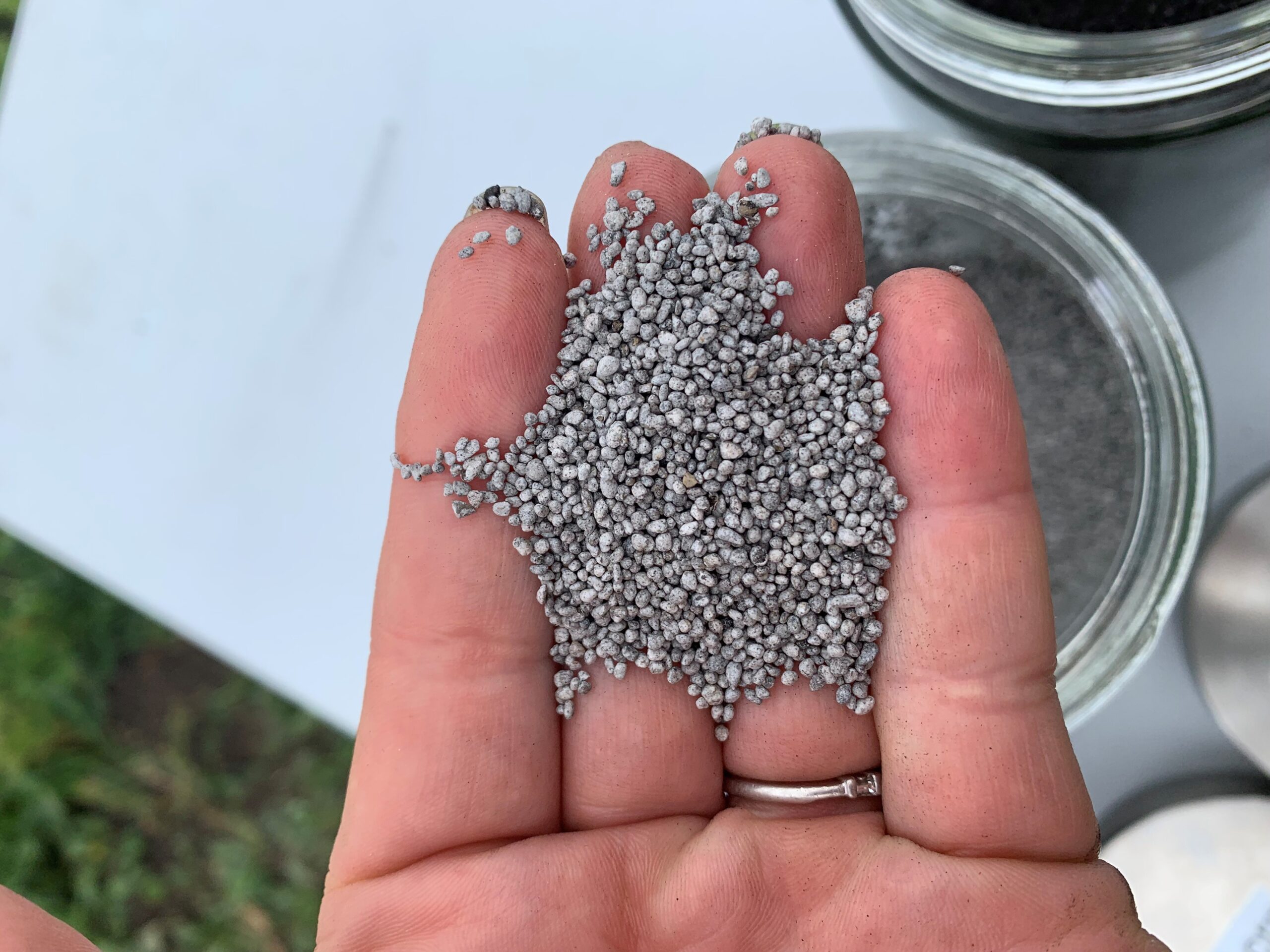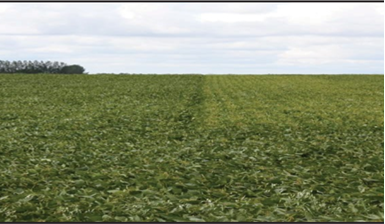Background
To ensure an effective degree of nodulation by Bradyrhizobium japonicum inoculants on soybeans, some producers have been applying up to double the recommended rate of in-furrow granular inoculant during seeding, to enhance nodulation on lateral roots. Previously, small plot studies suggested that higher application rates over current inoculant manufacturers’ recommendations may provide higher yields in some cases. The optimal inoculant application rate in Saskatchewan soils needed to be determined in order to maximize profit for producers.
Purpose
Validation of small plot research findings with granular inoculation rates of soybeans under actual field scale conditions were carried out to evaluate if the results found in small plot would apply to growers in the field. To do this, growers seeded soybeans with their standard farming equipment and practiced using granular inoculant at up to 2x the manufacturers’ recommended rate, to evaluate effects on yield, nodulation efficiency, and net return. The goal of the study was to determine whether there was an optimal rate for granular in-furrow inoculant to maximize profit of growing soybeans in Saskatchewan.


Design of Experiment
A total of nine producers were recruited for seeding replicated test plots within their regular soybean rotation, under normal agricultural practices of their operation (Table 1). Each grower site had three target granular inoculant rates (1x, 1.5x, and 2x of the manufacturers’ recommended granular inoculant rate), replicated three times (Figure 1). The size of each replicated plot was the width of the grower’s seeder by a length of at least 1,000 feet. This typically gave an area of one to two acres for each replicate plot at each site (Figures 3, 4, 5). Sites were visited on six occasions throughout the crop season (May to September, 2017) in order to collect key trial information such as:
- seed treatments
- inoculants
- soil tests
- crop inputs
- seeding depth and row spacing
- actual seeding rates
- observations on soil moisture
- rainfall
- disease scoring
- weed impact scoring
- insect pressure
At harvest, the gross yield weight for each individual replicate plot was determined separately by using a weigh wagon. Yield measurements for each plot were then normalized to 14 per cent seed moisture content.
Different varieties of soybeans, on-seed inoculants, and in-furrow granular inoculants were chosen by each grower (Table 1).
Results
Dry conditions in Saskatchewan in 2017 directly impacted the results of the study, as some sites were limited by moisture which led to lower yields (Figure 1). Actual regional rainfall for each location can be found in Table 1. The Craik, Duval, and Saltcoats sites had yields below 20 bushels per acre (bu/ac) due to poor environmental and field conditions.
Overall, soybean yields did show a positive correlation with increased inoculation rate (Figure 2). Response to increasing rates of granular inoculant was statistically significant at five of the sites (Watrous, Viscount, Halbrite, Estevan, Griffin) for at least one pairwise rate comparison (Table 3). Lumsden, although not statistically responsive due to higher variability, was included in Figure 2, as there is a trend that is visually consistent with the overall response to granular inoculant rates.
The increased yield response was highly dependent on the trial site, and was observed only where conditions did not severely impact yield. At most sites the 1.5x and 2x inoculation rates showed increased size and number of nodules on peripheral roots, as compared to the 1x rate. Some sites had considerably higher nodulation and larger nodules at the higher inoculation rates, but this did not necessarily correlate with increased yields at all sites.


Grower preferences for granular (in-furrow) inoculants differed by site, and included:
- Monsanto BioAg Cell-Tech® Granular
- Monsanto BioAg TagTeam® Granular
- Verdesian Life Sciences N-Row®
On-seed inoculants used by growers in this study included:
- BASF Nodulator Pro 100®
- Verdesian Primo®
- Monsanto BioAg Optimize ST®
- Monsanto BioAg Cell-Tech® Liquid
Sites with a previous history of soybeans in their rotation may have had a pre-existing population of Bradyrhizobium japonicum in the soil, which may have reduced the observed yield effect from an increased inoculant rate incorporated in 2017.
Economic Implications
The two highest responding sites (Watrous and Viscount) for increased granular in-furrow inoculation rate on soybean yield started at a 1x inoculation rates of 4 pounds per acre (lb/ac) and 3.8 lb/ac respectively, which was just above the manufacturers’ recommendation of 3.6 lb/ac (100 per cent rate) for the row spacing at those sites (Figure 2).
Across the six trial sites that saw a yield response, an estimated granular inoculant MSRP of $2.81/lb to $3.35/lb (depending on manufacturer) and a soybean contract price of $380/tonne were used for return on investment calculations using each site’s specific trend line equation (Figure 2, Table 2).
By doubling the inoculation rate from 100 to 200 per cent of the manufacturers’ recommended rate, the Watrous site had the greatest net profitability increase of $27.64/ac. Viscount had a net profitability increase of $7.81/ac, Lumsden had $5.06/ac, and the other three sites had a decrease in profitability (Table 2). The individual site trend lines suggest that for every 1 lb/ac (1.12 kg/ha) increase in granular inoculant rate, the most profitable site (Watrous) would net an increase of $7.68/ac (up to inoculation rates as high as 222 per cent of recommended). The other sites were lower, and three of the yield responsive sites had negative returns at higher inoculation, as low as -($1.19)/ac for the Estevan site.
At the three non-responding sites where yield was not influenced by inoculation rate (Figure 1), it was unprofitable to increase the inoculation rate over the manufacturers’ recommendation. It was observed that conditions such as drought, and good agronomic practices such as weed management, will ultimately play the most important role in soybean yields. Where conditions and fields allowed the soybeans to be able to respond to the treatments, an increase in yield was observed, even though it was not always economic at all rates.
Table 1. Site Locations and Details. Rainfall amounts are regional from planting date to harvest date.
| Site Location | Rural Municipality | Variety Name | In-Furrow Inoculant | On-Seed Inoculant | Row Spacing (inches) | Actual 1x Inoculation Rate (lb/ac) | Rainfall (planting to harvest) (mm) | % of 30 year average rainfall (Apr-Aug) |
|---|---|---|---|---|---|---|---|---|
| Halbrite | Cymri No. 36 | TH 33003 R2Y | N-Row Granular | Primo | 12 | 5.0 | 173 | 66% |
| Lumsden | Dufferin No. 190 | 22-60RY | TagTeam Granular | None | 10 | 5.0 | 72 | 31% |
| Griffin | Fillmore No. 96 | S007-Y4 | N-Row Granular | Primo | 14 | 5.0 | 103 | 38% |
| Estevan | Cymri No. 36 | TH 32004 R2Y | N-Row Granular | None | 12 | 5.0 | 172 | 65% |
| Duval | Last Mnt Val No. 250 | NSC Star City RR2X | Cell-Tech Granular | Nodulator Pro 100 | 10 | 5.0 | 97 | 38% |
| Viscount | Viscount No. 341 | 22-60RY | TagTeam Granular | Optimize ST | 12 | 3.8 | 152 | 55% |
| Craik | Craik No. 222 | ISIS 6th generation | N-Row Granular | Bare seed | 12 | 3.6 | 144 | 53% |
| Saltcoats | Saltcoats No. 213 | Barron R2X | TagTeam Granular | SoyRhizo Cell-Tech | 8 | 5.9 | 148 | 51% |
| Watrous | Wood Creek No. 281 | P002T04R | TagTeam Granular | Optimize ST | 12 | 4.0 | 155 | 56% |
Table 2. Economics of Doubling Inoculation Rate on Soybeans.
| Site | GAIN bu/ac | GAIN $/ac | Row Spacing (inch) | Granular Inoculant MSRP $/lb | 100% Manufacturers’ Inoculation Rate (lb/ac) | 200% Manufacturers’ Inoculation Rate (lb/ac) | Cost of Extra Inoculant ($/ac) | NET Return ($/ac) | Ratio Cost:Gain |
|---|---|---|---|---|---|---|---|---|---|
| Watrous | 3.84 | $39.70 | 12 | $3.35 | 3.6 | 7.2 | $ 12.06 | $27.64 | 1 : 3.29 |
| Viscount | 1.92 | $19.87 | 12 | $3.35 | 3.6 | 7.2 | $ 12.06 | $7.81 | 1 : 1.65 |
| Halbrite | 0.96 | $9.97 | 12 | $2.81 | 3.6 | 7.2 | $ 10.12 | -$0.15 | 1 : 0.99 |
| Griffin | 0.56 | $5.84 | 14 | $2.81 | 3.1 | 6.2 | $ 8.71 | -$2.87 | 1 : 0.67 |
| Estevan | 0.56 | $5.82 | 12 | $2.81 | 3.6 | 7.2 | $ 10.12 | -$4.29 | 1 : 0.58 |
| Lumsden | 1.88 | $19.46 | 10 | $3.35 | 4.3 | 8.6 | $ 14.41 | $5.06 | 1 : 1.35 |
| Average (6) | 1.62 | $16.78 | 12 | $3.08 | 3.6 | 7.3 | $ 11.24 | $5.53 | 1 : 1.49 |
The net return is shown for a doubling of the manufacturers’ recommended inoculation rate (based on product and row spacing). The average of the six sites analyzed had a return of $16.78 in additional yield ($/ac) on an extra $10.86/ac spent on inoculant. Results were quite variable between sites, with only three of six responsive sites showing a positive economic return.

Table 3. Paired t-test results per site versus inoculant rate treatment pair.
| Site | 1x vs 2x | 1x vs 1.5x | 1.5x vs 2x |
|---|---|---|---|
| Craik | 0.623 | 0.652 | 0.955 |
| Duval | 0.888 | 0.995 | 0.923 |
| Estevan | 0.108 | 0.499 | 0.093 |
| Griffin | 0.730 | 0.097 | 0.494 |
| Halbrite | 0.333 | 0.082 | 0.644 |
| Lumsden | 0.475 | 0.214 | 0.683 |
| Saltcoats | 0.894 | 0.788 | 0.853 |
| Viscount | 0.036 | 0.149 | 0.472 |
| Watrous | 0.004 | 0.088 | 0.193 |
Five of the nine sites showed a statistically significant result in at least one inoculant rate treatment pair comparison. P- values <0.05 (95 per cent confidence interval) are highlighted in green, while p-values <0.1 (90 per cent confidence interval) are highlighted in yellow.
Recommendations Based on Trial
The results of this project showed that increasing the granular (in- furrow) inoculation rate above the manufacturers’ recommended rate could be profitable at 150, 200, and even beyond 200 per cent at some sites (Figure 2). Six of nine sites did show a positive yield response, but the response was variable across all sites. The average response for those six sites found that for every 1 lb increase in granular inoculant rates above the recommended rate, growers could expect an increase in yield of 0.71 bu/ac. At individual sites the response ranged from 0.16 to 1.07 bu/ac.
Three sites with lower yields were not impacted by granular inoculant rates, suggesting something else limited yields, and likely was attributable to dry conditions.
This type of trial, done over multiple years, will provide more comprehensive advice based on average growth conditions. Future trials could also determine whether double inoculation is effective on yield response above what is seen with just an on-seed inoculant.
The granular in-furrow inoculation rate (lb/ac) is dependent on the soybean row spacing. The greater the row spacing, the less granular inoculant is needed because it is incorporated only in the furrow. In this 2017 study, most producers were using a 1x inoculation rate that was above 100 per cent of the manufacturers’ recommended rate, based on inoculant product and soybean row spacing (Figures 1 and 2).
References
- 1Holzapfel, C. “Developing Nitrogen Management Recommendations for Soybean Production in Saskatchewan”. Saskatchewan Pulse Growers project # AGR1508 Year 2 Progress Report. http://iharf.ca/wp-content/uploads/2017/04/Developing- Nitrogen-Management-Recommendations-for-Soybean-Production-in-Saskatchewan-interim-report.pdf
Acknowledgements
AgCall Inc. and Prairie Agricultural Machinery Institute (PAMI) provided recruitment, trial management, and reporting services for this study.

Developing nitrogen management recommendations for soybean production in Saskatchewan
Chris Holzapfel Indian Head Agricultural Research Foundation


